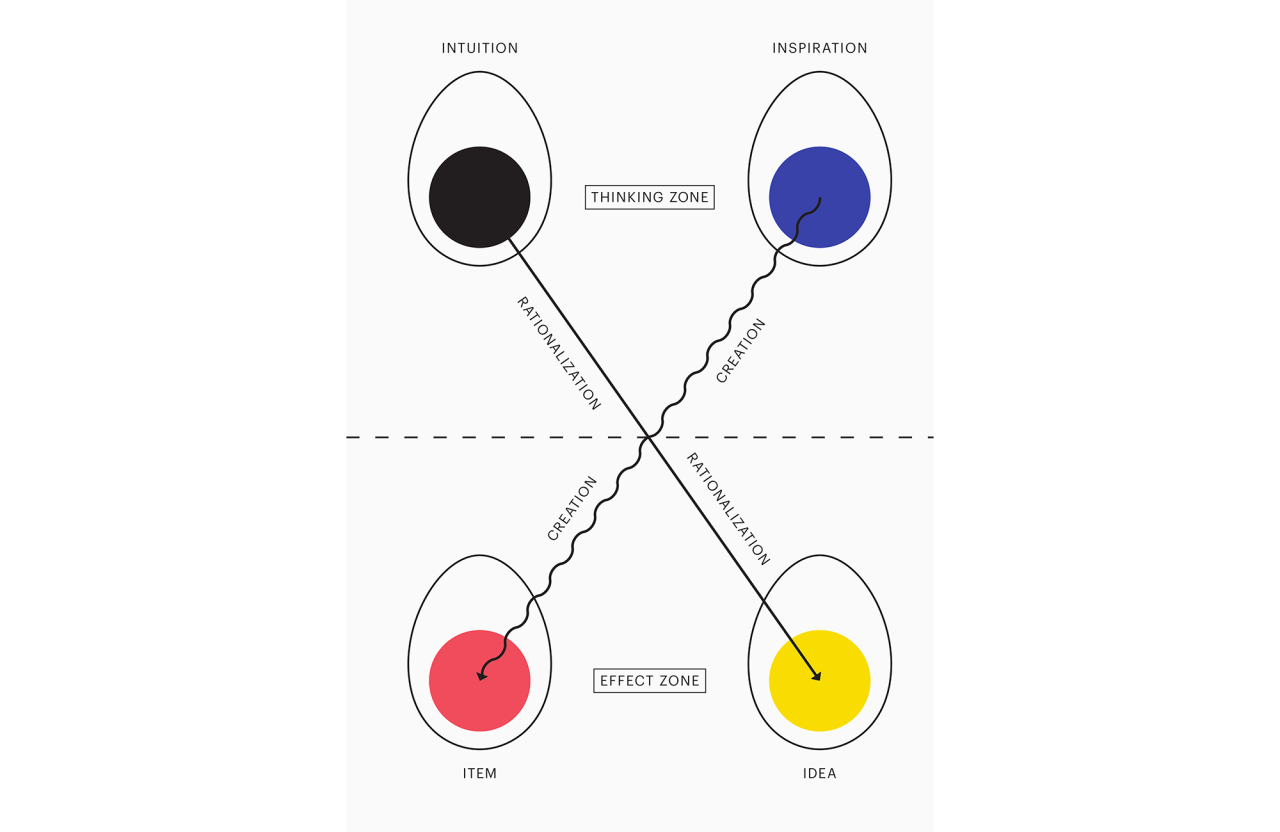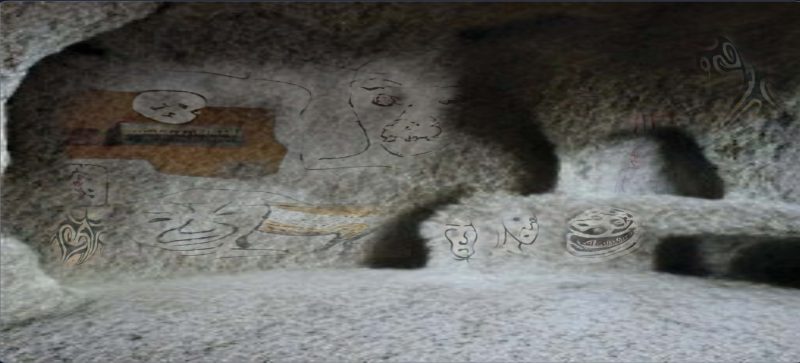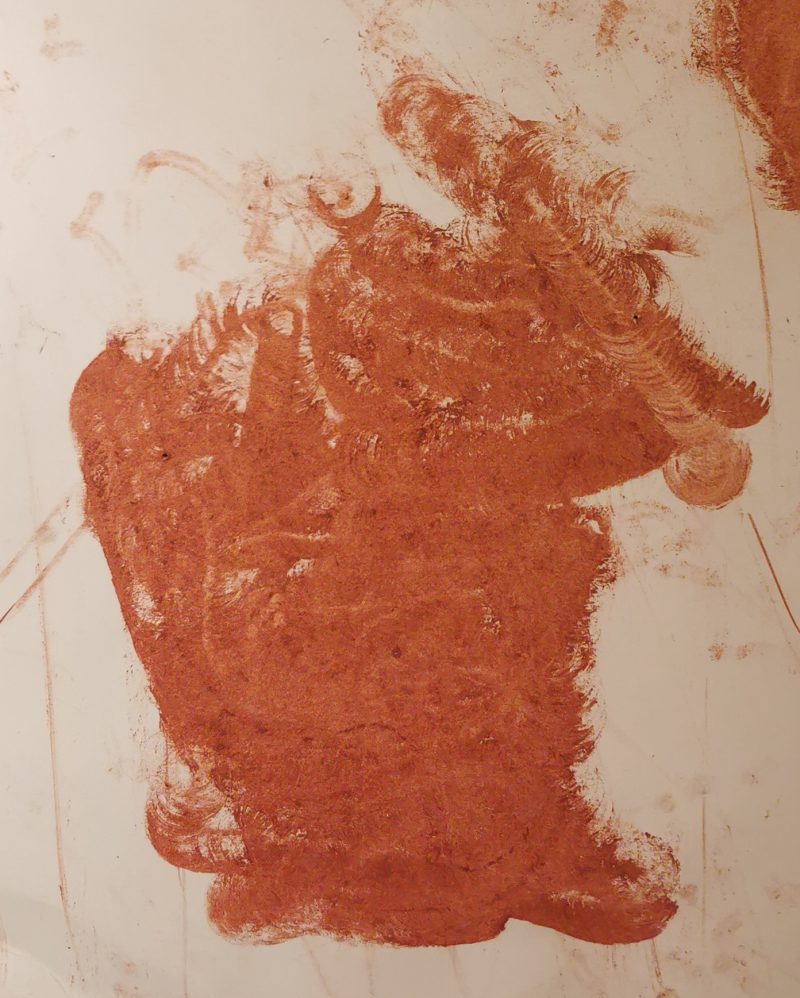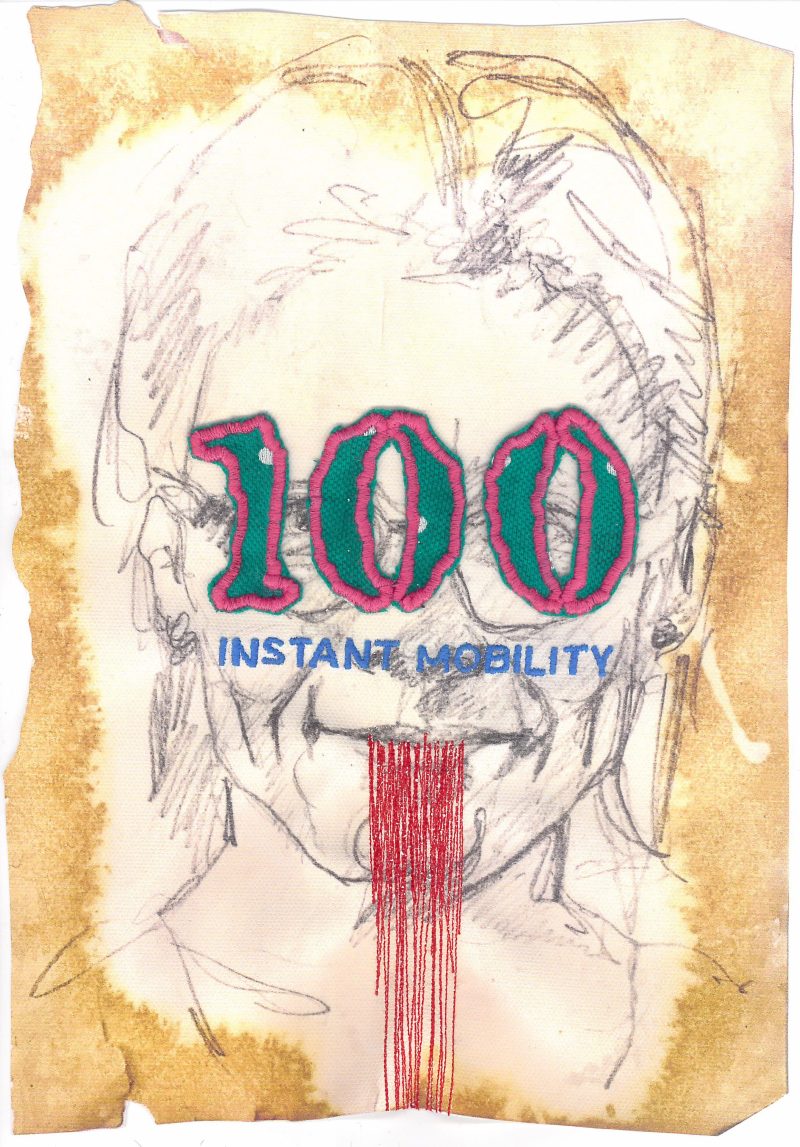
Jarosław Lubiak
COSMOS ON A SHEET OF PAPER, INADVERTENTLY … ON THE ARTISTIC MONADOLOGY OF HONZA ZAMOYSKI
Cosmos On A Sheet Of Paper And In A Gallery Box – that could be the title to capture all (three? what about the others?) dimensions of the universe according to Honza Zamojski. Such a title, however, would be too long and literal, and yet there needs to be room for inadvertence, enabling the birth of this cosmos. Let us therefore confine ourselves to the very sheet of paper on which the universe appears. It can be folded to create a three-dimensional form – for example, it can be bent to create a model of an exhibition space or put together to form a book.
The sheet of paper, the book, the gallery box – these are the main (though not exclusive) formats of Zamojski’s artistic activity. His main medium is drawing, often transforming into graphic design. These formats and media allow Zamojski to move freely between areas and roles in art, such as artist, graphic designer, curator, as well as publisher and academic lecturer. This allows him to establish a truly transdisciplinary practice.1
COSMOS, WORLD, PLURIVERSUM
One of the early examples of cosmogenesis according to Zamojski is the work entitled Gradient from 2011–2013. It is formed of sheets of paper, planes of text or sequences of letters, words and sentences, volumes of a book, all stacked in a pile. These are 13 copies of Witold Gombrowicz’s Cosmos, lying horizontally one on top of the other. The varying degrees of yellowing and greying of the covers define the eponymous gradient: from dark yellow to light grey.
One can imagine that just after the book was published, the stack would have looked very different – the copies would have been perfectly identical. They could serve as an illustration of perhaps one of the greatest conundrums arising from Gilles Deleuze’s book Difference and Repetition: what is the difference between two copies of the same book.2 In Zamojski’s work, the question of differentiation in the repetition of the same is sidelined by the superficial differences caused by the degradation of the covers. As a result, each piece is different – we have 13 different cosmoses.
If we understand the cosmos as a whole organised in an orderly way, the yellowing and greying of the covers reveals the process of entropy. The cosmos is swallowed up by chaos. Was it not one of the messages contained in the Gombrowicz’s work? Interestingly, Deleuze mentions this novel in Difference and Repetition because it provides him, together with the works of writers such as Joyce and Borges, with the evidence to conclude that ‘chaos = cosmos’, and, later, to develop on this basis the thesis that cosmos emerges from chaos.3 In this context, Zamojski’s Gradient shows the manifestation of chaos in the cosmos(es?).
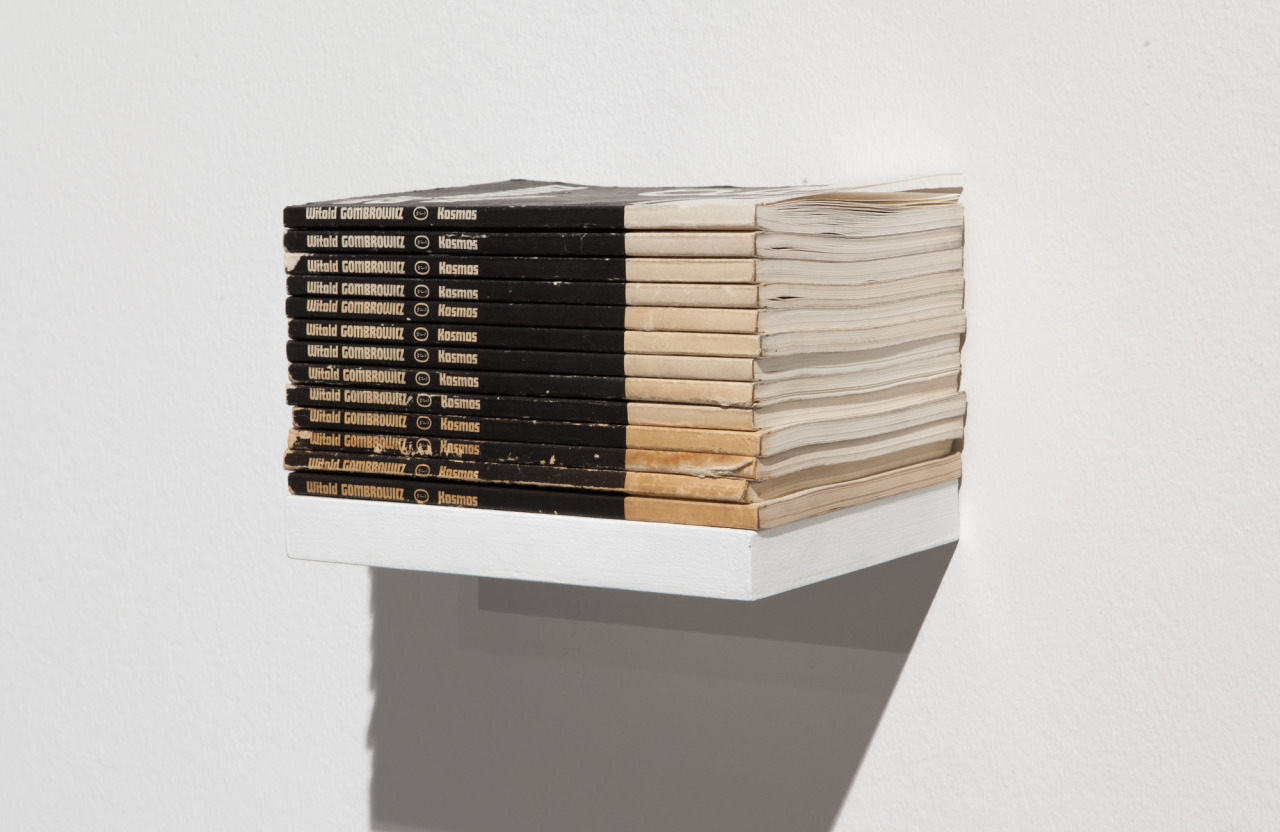
Honza Zamojski, Gradient, ready-made, 13 x Kosmos Witolda Gombrowicza, 2011–2013
Cosmos returns in another book, this time designed by the artist himself. Publication Robert Maciejuk, Honza Zamojski. Kosmos i kosmos i okolice (Robert Maciejuk, Honza Zamojski. Cosmos And Cosmos And Surroundings) was published in 2013.4 It is a set of reproductions of sketches, drawings, collages, blueprints, diagrams, charts, photographs and even paintings: figural elements intertwine with abstract ones, plays on plastic forms with plays on words. The whole is given the character of a story, as the last drawing features the word ‘FIN’. The impressive ‘album’ turns out to be a narrative about the emergence of the world. It can be associated with the ‘primordial soup’ – that mixture from which the universe as we know it emerged (the ‘concoction’ of particles is supposed to have emerged soon after the Big Bang) or life as we know it on Earth (a prebiotic emulsion). Here, we are dealing with a primordial soup of plastic particles in the process of the emergence of a form. At the same time, the suggestion of a narrative structure prompts us to relate this book to Gombrowicz’s novel, which it seems to mock. Zamojski’s publication appears at first glance to be an anti-cosmos, the suggestion of the narrative, and perhaps even of the plot, is a joke, but, at a deeper level, the two books are connected. They propose an immersion in chaos, they show the becoming of the cosmos as chaos. Ultimately, in Zamojski’s work, it is difficult to decide whether we are dealing with the formation and disintegration of forms or rather an attempt to capture in a fixed form the process of the transformation itself. Cosmogenesis is infinite in duration and becoming, and the caption ‘FIN’ applies only to the form of the book, for this form must have a beginning and an end.
An additional effect here is that of a doubling, in which the game of distinguishing and not distinguishing is played. Two artists, two covers, a book and an exhibition, create a constellation of worlds. Both artists belong to different generations and their artistic practices are distinct, although they have collaborated before: Zamojski curated Maciejuk’s exhibition in the Poznań’s Starter Gallery in 2012 and wrote Wazony [Vases], a work dedicated to the series of the painter’s ceramic vases, published by the Morava publishing house in 2011. In Cosmos And Cosmos And Surroundings, the authorship of individual elements is not specified, the two artistic worlds merge and the viewer can only try to distinguish them on the basis of their own knowledge of style of the two artists. And at the same time, their distinctiveness is not abolished, which is clearly signalled by the two names in the title and the repetition of the word ‘cosmos’. What is more, part of the print run has a cover using a drawing by Maciejuk and the other part a graphic design by Zamojski. In the latter, the word ‘cosmos’ in the artist’s distinctive font occurs only once. The primordial plastic soup resembles a sophisticated drink: shaken but not stirred.
The game of doubles also includes the publication and exhibition Robert Maciejuk, Honza Zamojski. Up and Down presented at the Zachęta – National Gallery of Art in Warsaw in 2013.5 The exhibition and the book are two completely different worlds, even though created from works by the same artists, curated by the same person as designer or informal curator. The exhibition is also an attempt to bring two cosmoses together, or more precisely to create some kind of common microcosm of them in the two rooms of the Zachęta. Cosmogenesis takes place in a different way here: it is more like folding a sheet of paper to get the third dimension, by lifting the sides to make walls. This method is revealed by a ladder folded so that it lies on the floor and supports itself against the wall. It gives the impression that it is the result of a design error. The key objects of the exhibition appear to be paradoxical spatial realisations of orthogonal representation. The central object, a schematic human figure, is a form from Zamojski’s drawings ‘projected’ into space. At the same time, the arrangement of elements on the gallery walls repeats the compositional patterns of the graphic designs. This effect is enhanced by painting some of the walls: one of them blue, others yellow. While the usual white used in exhibition interiors is meant to dematerialise their architectural form, giving the impression that the objects are suspended in an undefined space, the solution used by Zamojski brings out the planes of the walls. The worlds of Maciejuk’s and Zamojski’s artistic practices, the universe enclosed in the book and the microcosm created in the gallery, constitute a pluriversum around the collaboration between the two artists at the Zachęta Gallery.
The issue of the multiplicity of worlds returns in the project
WRLD(S) in 2022 at BWA Wrocław Główny, where Honza Zamojski acts as curator.6 While for the Warsaw exhibition the key issue was to play out the relationship between the two artists and between the artefacts in the gallery space, as well as between the arrangement and the audience, in the Wrocław project the emphasis is put on the relationship between the two spaces. The universe of the exhibition bifurcates into two worlds that jointly catch the artistic worlds of the participants. The pretext for this idea is the architecture of the venue itself: the division of the exhibition space into two separate and distant sets of rooms. Architecturally, the two parts are symmetrical reflections of each other. Zamojski transforms this fact into the principle of the exhibition. The works of each artist are present in both galleries and in the same locations respectively.
There is a more complex relationship between the two parts of the exhibition. One room is described as light, the other as dark, although the curator emphasises: ‘These are not oppositions. The lightness and darkness of the rooms symbolise nothing.’7 They become a sign of bifurcation and doubling, making it possible to unravel the web of relationships between works in the same part and between different parts. This is done in a number of ways: repetition, ‘negative-positive’ reversal, reflection in content, reflection in form, and in some cases some kind of tension between one artist’s works derives from their placement in this exhibition context.
The choice of artists and works is very unobvious, may even seem arbitrary, but is the result of an effort to weave an intricate web of relationships and to create a surprise effect. The emoji of amazement appearing in the title defines both the aim and the rhetoric of the project: to create an effect of surprise or even bewilderment. The bifurcation and doubling also serves this purpose, although it has an additional significance – I would venture to say that it reveals Honza Zamojski’s creative philosophy. Or at least it suggests it.
ARTISTIC MONADOLOGY
Cosmogenesis, which resulted in the exhibition WRLD(S), is an artistic experiment addressing the problem of incompossibility. It was introduced into philosophy by Gottfried Wilhelm Leibniz to resolve the question of the relationship between the truth and the possible. It has recently been revisited by Gilles Deleuze, starting from the paradoxes of ‘contingent futures’, known since antiquity: ‘If it is true that a naval battle may take place tomorrow, how are we to avoid one of the true following consequences: either the impossible proceeds from the possible (since, if the battle takes place, it is no longer possible that it may not take place), or the past is not necessarily true (since the battle could not have taken place). […] Leibniz says that the naval battle may or may not take place, but that this is not in the same world: it takes place in one world and does not take place in a different world, and these two worlds are possible, but are not ‘compossible’ with each other.’8 Building on this, Deleuze argues that all possibilities exist virtually, but as they are incompossible, only one selected possibility is actualised.9
Such a situation is illustrated – and can even be experienced – in the exhibition WRLD(S). When I am in one part of it, the other part becomes virtual – only one of them can be perceived as current at any given time. It creates a bizarre experience: when I am in the first part, I fantasise about what I will see in the other, while having moved on to the second I recall what I saw in the first. I would like to see simultaneously what I have in front of my eyes and what I cannot see. The entire exhibition is a virtual world that bifurcates and doubles into two incompossible (perceptually) worlds of light and dark parts. The number itself is only due to the spatial conditions at BWA Wrocław Główny. It is purely a sign of a potentially infinite number of worlds.
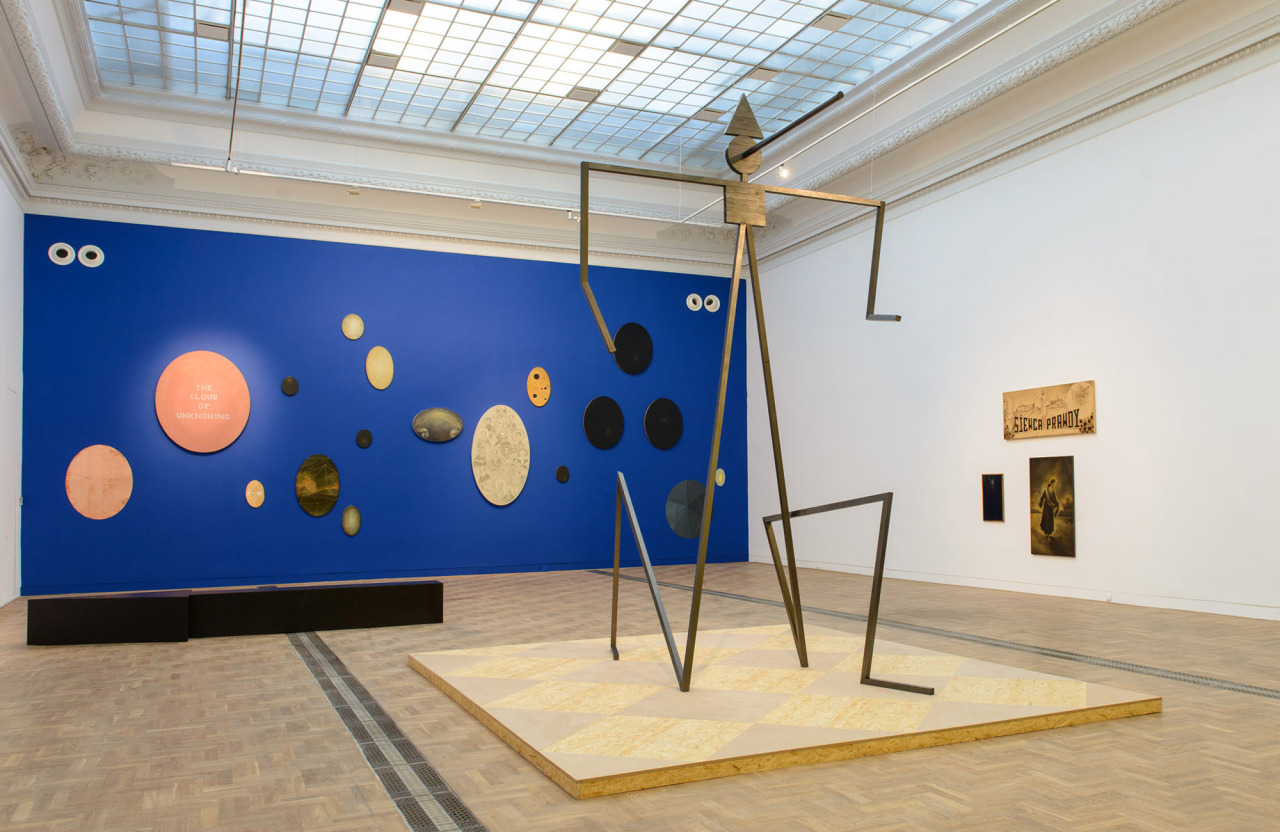
Honza Zamojski, „Zdezorientowany człowiek”, grafit na drewnie, 2013, fragment wystawy Robert Maciejuk, Honza Zamojski. Góra i dół, Zachęta Narodowa Galeria Sztuki w Warszawie, 30.11.2013–16.02.2014. W tle prace Roberta Maciejuka
Zamojski creates cosmoses and worlds within the universe of his art. We should not understand this metaphorically, as it is actually happening. The sheet of paper can become a monad in which the entire universe is expressed. We return at this point to Leibniz’s philosophy and its contemporary reading. The basic premise of his monadology is that the world is made up of monads and, as Deleuze writes, it ‘does not exist outside of the monads’ and ‘each monad (…) conveys the entire world’.10 In a beautiful but puzzling passage in the Monadology – paragraph 67 – Leibniz states: ‘Each portion of matter [or Monad – J.L.] may be conceived as like a garden full of plants and like a pond full of fishes. But each branch of every plant, each member of every animal, each drop of its liquid parts is also some such garden or pond.’11 The smallest particle contains and expresses the whole world, but as Deleuze emphasises: ‘It clearly expresses only a certain limited zone or area depending on one’s point of view (positioned corner). This illuminated region undoubtedly includes every body.’12 The singularity of a monad is determined by its inherent singularities. The French philosopher specifies: ‘Each monad can express clearly only a certain part of the universe: the region defined by the singularities that constitute it’, and adds, ‘Each unit expresses the whole universe: the singularities constituting each unit in fact extend in all directions up to the singularities of the other units, insofar as the corresponding sequences coincide, so that each unit contains the totality of a certain compossible world and excludes only other worlds incompossible with it (where the sequences diverge).’13
Leibnizian monadology, of course, will not explain for us Zamojski’s artistic practice in a straightforward way, but it can provide a starting point and a reference point to grasp what is encrypted in it. Leibniz called it the ‘cryptography’, i.e., ‘the art of finding the key to shrouded things’.14 Three elements – the teeth? – of this key has already prompted us: inclusion (containing), expression (expressing) and singularity (defining forms of expression). If Zamojski’s work is a monad, then it is necessary to recognise the singularities that condition what it expresses clearly. If his artistic practice can be described as monadological, it would be a peculiar and even singular monadology. Its distinctiveness derives primarily from the fact that it is not a theoretical science of how the world works, but precisely the practice of making it. Moreover, the artist’s aim is not to explain the created world, but to ‘shroud’ it. Zamojski’s artistic monadology is a reverse cryptography: he uses typography and ideography to create hieroglyphs and multiply riddles. The cosmos created on a piece of paper is a puzzle.
Zamojski’s artistic monadology is primarily a practice, but it also contains theoretical and speculative moments. In 2014 Four Eggs Theory was published in the form of an exhibition and publication as part of a project at the FUTURA Centre for Contemporary Art in Prague.15 The publication is essentially an ideographic and typographic treatise on the creative process. The starting point has the form of a hard-boiled egg cut in half along the longer axis. This shape becomes for him an astronomical model, in which the yolk is the sun and the outer line is the Earth’s orbit. It is a fictional moment to identify the two shapes, as the egg resembles the figure of oval with a single axis of symmetry, while the Earth’s orbit is shaped like a regular ellipse (which, strictly speaking, is not an oval). This small gesture sets in motion the whole process of fictionalisation that conditions this work. The next step is to equate the astronomical egg with a model of the creative process: the sunny yolk is replaced here by a form resembling a shooting target with a red circle in the centre, surrounded by enlarging rings of yellow, blue and black – this is the work. The artist orbits around it along the oval orbit, in a perpetual cycle of approaching and moving away from the yolk – the sun – the nucleus of his practice. The work as a process is the relationship between the four eggs – Inspiration, Intuition, Item and Idea. The artist explains how they work using his own example: ‘If I were to apply the Four Eggs Theory back to myself, it would essentially look as follows: I have an intuitive need (Intuition) to organise the world of matter (Item) and ideas (Idea) around me, so, inspired (Inspiration) by the theoretical considerations of writers, poets and artists, as well as various artefacts, I am constantly thinking about how (Idea) can convey my knowledge in a logical way, for example by writing this text (Item). It all adds up to a Work that is part of a larger whole, a practice.’ In the creative process, the subject experiences different states; their analysis is presented in the ideogram: the artist orbits the work along the outer line of the astronomical egg, the moment of curiosity is located at the perihelion of this orbit, while the moment of satisfaction is located at its aphelion, with boredom, disappointment and uncertainty in between. Paradoxically, satisfaction, even when singled out as a desirable outcome of artistic work, is furthest removed from the work itself, while curiosity is closest to it.
The egg here becomes a monad that contains the whole world (the astronomical egg), as well as the world of creation (the egg of the work) and the individual eggs of the creative process (first the four of Inspiration, Intuition, Item and Idea, and then more and more eggs as the analysis becomes more detailed).
Why an egg? Because it all starts with an egg. The work Breakfast according to Fibonacci (2014) is a ready-made consisting of two eggs, a cup with an unpoured tea bag, an apple on a plate, a bowl of oatmeal and a plate of toast. All these elements are arranged in a pattern of squares illustrating the Fibonacci geometric sequence. The lengths of the sides of the squares are in such proportion to each other that they fit into the sequence of numbers 1:1:2:3:5. The two eggs are located in two smallest squares corresponding to the number 1.

Honza Zamojski, „Śniadanie według Fibonacciego”, 2011–2013
INFRAPOLITICS OF HUMORESQUE
The version of the text accompanying the Theory of Four Eggs exhibition at Futura contains one-sentence footnote, which is not included in the publication: ‘Given the concepts we are dealing with – Intuition, Inspiration, Idea and Item – one could just as well speak of the Theory of the Four ‘I’s’’.16 It is not difficult to guess why the artist abandoned this idea (and footnote): it would have precisely defined the content of his thoughts, but would have lacked pictorial power. His argument on the creative process is convincing, well-structured and logically coherent, and is also an interesting theoretical proposal. But Zamojski is not about that. His ‘treatise’ uses ideography and typography, reverses Leibnizian cryptography to create hieroglyphics, visual puzzles.17 His main focus is what cannot, as a rule, be spoken or shown directly, namely humour.
Finally, we arrive at the issue with which the artist is associated and the importance of which he emphasises in his work.18 It is difficult to undertake because it is based on something as difficult to grasp as the feeling. Let us try to get closer to the humour in Zamojski’s work. One of his works can easily highlight this difficulty. Zamojski performed it together with Konrad Smoleński. The Banner (2016) is described by the artists as a permanent performance: a small group of people dressed in dark sportswear walk unhurriedly but briskly on a moving treadmill. The paradox is that if it was attributed solely to one artist, its meaning would change radically. If it were considered Smoleński’s oeuvre, it would take on a dramatic character. In contrast, in the context of Zamojski’s oeuvre, it takes on a humorous, even comic character.
The mechanic aspect of movements, or more precisely the mechanisation of human bodies, can be something tragic when we think of it as turning humans into robots. It will be different if we manage to see in it an exposition of the automatisms inherent in human corporeality, a disclosure of the extent to which we are all puppets without realising it. This second recognition would meet the central argument of Henri Bergson in his treatise Laughter: An Essay on the Meaning of the Comic.19 Especially when he writes: ‘The attitudes, gestures and movements of the human body are laughable in exact proportion as that body reminds us of a mere machine’.20 The philosopher extends this observation by locating the source of comicality in the ‘something mechanical encrusted upon the living’.21 This mechanisation is achieved through three basic modes: repetition (‘The truth is that a really living life should never repeat itself’22), reversal, turning into the opposite (‘turn it upside down’23), and superimposition, the simultaneous belonging to completely separate and independent categories (an example is to play with the metaphorical and literal meaning of words). All three modes ‘consist in looking upon life as a repeating mechanism, with reversible action and interchangeable parts. Actual life is comedy just so far as it produces, in a natural fashion, actions of the same kind, – consequently, just so far as it forgets itself, for were it always on the alert, it would be ever-changing continuity, irrevertible progress, undivided unity.’24 In Bergson’s analyses, the modes of mechanisation are at the same time tricks that are used to produce a comic effect – humour is triggered when revealing modes in which life denies its vitality, falling into automatisms.
The modes recognised by Bergson can be found in Zamojski’s cosmogenesis, which creates worlds through repetition, reversal, superimposition. They all appeared in the exhibition WRLD(S) as tools for creating relationships between works in a spatial split. A constant motif in the artist’s oeuvre, the schematic human figure – the graphic humanoid – which appears both in his drawings and as sculptures or installations, is created through the joint action of three tricks, in a repudiation of the great classical art motif of the representation of the human figure. Moreover, the creative process itself is subjected to ‘mechanisation’ – the artist uses tracing paper to create his drawings, incorporating an element of repetition, a reversal to the very core of creation. In the light of Bergson’s analysis, would this not be a humoristic technique par excellence?
Bergson links the three modes to what we might call the comic condition, which he describes with puzzling terms: absentmindedness and rigidity. He writes: ‘The rigid mechanism which we occasionally detect, as a foreign body, in the living continuity of human affairs is of peculiar interest to us as being a kind of ABSENTMINDEDNESS on the part of life.’25 Lack of attentiveness, weakened relationships with others and ourselves turn us into puppets controlled by automatisms. Mechanisation also occurs when insufficient vigilance is exercised over the course of events, when their functioning falls into established ruts – this is when the ‘absentmindedness in things’ occurs.26 When the action of the world descends into mechanicalness, another effect emerges, namely the rigidity ‘clashing with the inner suppleness of life’ and opposed to its mutability.27 It manifests itself in empty ceremonies and rituals, puffery and pompousness of behaviour, in the callousness of social regulations ‘setting itself up for a law of nature’.28 Both absentmindedness and rigidity are manifestations of the unsociality with which comedy is measured. ‘This corrective is laughter, a social gesture that singles out and represses a special kind of absentmindedness in men and in events.’29 Humour is therefore a tool that reveals these manifestations and allows their causes to be corrected, in order to re-socialise the world.
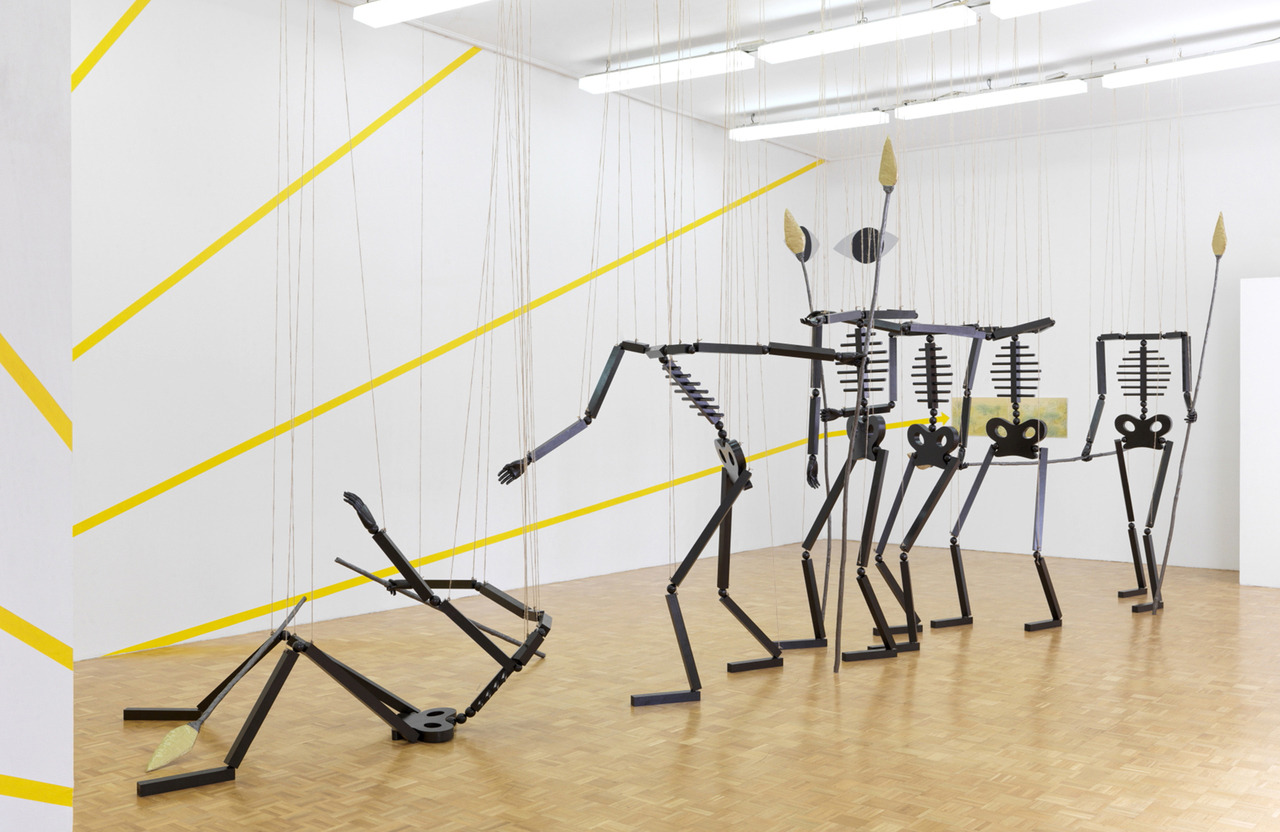
Honza Zamojski, „Upadek”, 2019, malowane drewno, liny, mural. W ramach 33. Biennale Sztuk Graficznych “Crack Up – Crack Down”, kur. Slavs and Tatars, Ljubljana, 07.06–29.09.2019.
Understood in this way, humour is a specific measure. Honza Zamojski’s practice, however, must be distinguished from activities in the field of art that also resort to this means and are called trickster strategies. These measures can be exemplified by the work of Oskar Dawicki or Piotr Uklański. In these strategies, the joke or prank is linked to the recognition of reality as oppressive and the quest for liberation. The trickster, as Anna Markowska writes, ‘does not wage war, but, feeling uncomfortable within the dominant norms, tries to break free’.30 However, this is primarily about freeing the artistic subject, while the society is left on its own.
Whereas in trickster strategies comicality is instrumentalised in favour of individual emancipation, in Zamojski’s case it is part of what might be called the infrapolitics of humoresque. As for the second term of this name, I propose it because it is the least loaded with the history of literary and theatrical comic genres, it refers to everyday situations and artistic interventions, and seems to best describe the strategy of overflowing humour employed by the artist. In contrast, the first term, coined by James Scott,31 was picked up by Slavs and Tatars on the occasion of the Crack Up – Crack Down exhibition which they curated as part of the 33rd Ljubljana Biennale of Graphic Arts. The exhibition was devoted to the relationship between art and satire, including that of a political nature, and in particular to the resistance of graphic arts in the service of satire.32 Scott calls infrapolitics ‘a wide range of low-ranking forms of resistance that dare not speak in their own name’, through which subordinate groups implicitly transcribe into the dominant discourse.33 Slavs and Tatars combined this with artistic practices in which subordinated groups use comic effects to resist imposed restrictions. The collective invited Honza Zamojski to participate in the exhibition, recognising these aspects in his work.
Due to the lack of space, I can only very briefly present the infrapolitics of Zamojski’s humoresque. Above all, it confronts the absentmindedness and rigidity that characterises the functioning of art, evoking a growing unsocialisation of the art field. For this, the artist uses a specific figuration that challenges the great opposition, proposed by Gilles Deleuze, between ‘Figure’ and ‘figuration’. ‘Figuration’ is what great painters like Francis Bacon manage to create ‘through extraction or isolation’, which opposes the mere figuration associated with the everyday and banal circulation of visual clichés in our pictorial culture.34 For Deleuze, figurativity is something subordinate, and the ‘great painters’ aim to tear apart clichés by opposing them their ‘Figures’. It is in them, that the pathos and ethos of the human existence and the existence of the world are to be manifested. But are we not dealing here with some kind of rigidity or perhaps even absentmindedness creeping imperceptibly? Do these ‘Figures’ of great painters not function like pompous marionettes when they join the commercial and institutional art circulation? Imagine one of Bacon’s paintings, for example depicting the Pope, juxtaposed with one of Zamojski’s drawings showing his ‘little man’ or with an installation in which he is drawn into space. This juxtaposition reveals the nature of the infrapolitics of humoresque, in which figuration, particularly the somewhat infantile figure of the little man, prefaces the pathos and ethos of humanism or posthumanism prevalent in the art world. It reveals that attentiveness and vigilance are often lacking here, which is why it falls into absentmindedness and rigidity, resulting in antisocial automatism. Zamojski’s figuration seems to apply the Bergson’s recognition: ‘we are never ridiculous except in some point that remains hidden from our own consciousness’.35
According to the rules of monadology, the art world contains and expresses both the social world and the cosmos as a whole.
1 At the same time, this constant crossing of boundaries seems to locate his practice away from the centres and the mainstream of production.
2 Cf. G. Deleuze, Różnica i powtórzenie, transl. B. Banasiak and K. Matuszewski, Warszawa 1997.
3 Ibidem, pp. 184, 281.
4 Robert Maciejuk, Honza Zamojski. Kosmos i kosmos i okolice, ed. J. Pieńkos, Warszawa 2013.
5 Robert Maciejuk, Honza Zamojski. Góra i dół, curatorial collaboration K. Kołodziej, Zachęta – National Gallery of Art in Warsaw, 30 November 2013–16 February 2014.
6 WRLD(S), exhibition within the framework of the Wrocław Drawing Triennial 2022, curator H. Zamojski, BWA Wrocław Główny, Wrocław, 20 May 2022–28 August 2022. Triennale was organised by the Eugeniusz Geppert Academy of Fine Arts in Wrocław.
7 H. Zamojski, WORLD(S), n.d., https://trwro.pl/wystawy/trw2022-worlds/ [access: 15 January 2023].
8 G. Deleuze, Cinema 2. The Time-Image, transl. H. Tomlinson and R. Caleta, Minneapolis 1997, p. 130.
9 G. Deleuze, The Fold Leibniz and the Baroque, transl. T. Conley, London 1993.
10 Ibidem, pp. 60, 25.
11 G.W. Lebniz, Monadology, transl. R. Latta.
12 Ibidem.
13 Ibidem.
14 Ibidem.
15 Honza Zamojsky: Teórie čtyr vajec, kurator Michal Novotný, Centrum pro současné umění FUTURA, Prague, 02. 4-10 May 2015, http://www.futuraproject.cz/futura/event/13-honza-zamojsky-teorie-ctyr-vajec [access: 20 January 2023]; H. Zamojski, Four Eggs Theory, Prague-Poznań 2015.
16 Honza Zamojsky: Teórie čtyr vajec, in: Centrum pro současné umění FUTURA, http://www.futuraproject.cz/futura/event/13-honza-zamojsky-teorie-ctyr-vajec [access: 20 January 2023].
17 The term “personal hieroglyph” is used by the artist himself. C. Vaz, Interview: Honza Zamojski, in: Art Map,
http://artresearchmap.com/artists/interview-honza-zamojski/ [access: 20 January 2023].
18 Cf.: M. Price, Honza Zamojski, in: Vitamin D3: Today’s Best in Contemporary Drawing, London 2021, pp. 294–295; Portfolio: Honza Zamojski, “Contemporary Lynx” 16 December 2021, https://contemporarylynx.co.uk/portfolio-honza-zamojski [access: 20 January 2023]; P. Strożek, Honza Zamojski, in: Culture.pl, January 2017, https://culture.pl/pl/tworca/honza-zamojski [access: 20 January 2023].
19 H. Bergson, Laughter. An Essay on the Meaning of the Comic, transl. C. Brereton L. Es L. (Paris), M.A. (Cantab) and F. Rothwell B.A. (London).
20 Ibidem.
21 Ibidem.
22 Ibidem.
23 Ibidem.
24 Ibidem.
25 Ibidem.
26 Ibidem.
27 Ibidem.
28 Ibidem.
29 Ibidem.
30 Trickster Strategies in the Artists’ and Curatorial Practice, ed. A. Markowska, Warsaw-Toruń 2013, p. 14.
31 J.C. Scott, Domination and Arts of Resistance: Hidden Transcripts, New Haven 1990.
32 Slavs and Tatars: Crack Up – Crack Down, ed. M. Constantine, Slavs and Tatars, International Center for Graphic Arts – Mousse Publishing, Ljubljana-Milan 2019, p. 8.
33 J.C. Scott, Domination…, op. cit., p. 19.
34 G. Deleuze, Francis Bacon: the logic of sensation, transl. Daniel W. Smith, London-New York 2003, p. 2.
35 Bergson, Laughter…, op. cit.
Works cited:
- Bergson H., Laughter. An Essay on the Meaning of the Comic, transl. Cloudesley Brereton L. Es L. (Paris), M.A. (Cantab) and Fred Rothwell B.A. (London).
- Deleuze G., Francis Bacon: the logic of sensation, transl. Daniel W. Smith, London-New York 2003.
- Deleuze G., The Fold. Leibniz and the Baroque, transl. Tom Conley, London 1993.
- Deleuze G., Cinema 2. The Time-Image, transl. Hugh Tomlinson and Robert Caleta, Minneapolis 1997.
- Deleuze G., Różnica i powtórzenie, transl. B. Banasiak and K. Matuszewski, Warszawa 1997.
- ‘Honza Zamojsky: Teórie čtyr vajec’, [in:] Centrum pro současné umění FUTURA, http://www.futuraproject.cz/futura/event/13-honza-zamojsky-teorie-ctyr-vajec [access: 20 January 2023].
- Lebniz G.W., Monadology, transl. R. Latta, https://en.wikisource.org/wiki/Monadology_(Leibniz,_tr._Latta), [access: 29 September 2023].
- ‘Portfolio: Honza Zamojski’, Contemporary Lynx 16 December 2021, https://contemporarylynx.co.uk/portfolio-honza-zamojski [access: 20 January 2023].
- Price M., Honza Zamojski, [in:] Vitamin D3: Today’s Best in Contemporary Drawing, London 2021.
- Robert Maciejuk, Honza Zamojski. Kosmos i kosmos i okolice, ed. J. Pieńkos, Warszawa 2014.
- Scott J.C., Domination and Arts of Resistance: Hidden Transcripts, New Haven 1990.
- Slavs and Tatars: Crack Up – Crack Down, M. Constantine, Slavs and Tatars, International Center for Graphic Arts – Mousse Publishing, Ljubljana-Milan 2019.
- Strożek P., ‘Honza Zamojski’, [in:] Culture.pl, January 2017, https://culture.pl/pl/tworca/honza-zamojski [access: 20 January 2023].
- Trickster Strategies in the Artists’ and Curatorial Practice, ed. A. Markowska, Warsaw-Toruń 2013.
- Vaz C., ‘Interview: Honza Zamojski’, in: Art Map http://artresearchmap.com/artists/interview-honza-zamojski/ [access: 20 January 2023].
- Zamojski H., Four Eggs Theory, Prague-Poznań 2015.
- Zamojski H., WORLD(S), n.d., https://trwro.pl/wystawy/trw2022-worlds/ [access: 15 January 2023].
Jarosław Lubiak
Dr Jarosław Lubiak, curator and art theoretician, lecturer at the Academy of Art in Szczecin.
ORCID: 0000-0002-8160-701X

